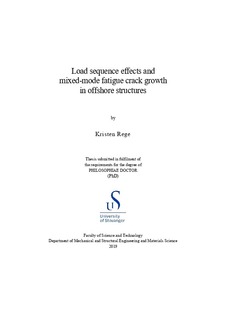| dc.contributor.advisor | Pavlou, Dimitrios G. | |
| dc.contributor.author | Rege, Kristen | |
| dc.date.accessioned | 2019-12-12T08:15:08Z | |
| dc.date.available | 2019-12-12T08:15:08Z | |
| dc.date.issued | 2019-12 | |
| dc.identifier.citation | Load sequence effects and mixed-mode fatigue crack growth in offshore structures by Kristen Rege, Stavanger : University of Stavanger, 2019 (PhD thesis UiS, no. 490) | nb_NO |
| dc.identifier.isbn | 978-82-7644-888-7 | |
| dc.identifier.issn | 1890-1387 | |
| dc.identifier.uri | http://hdl.handle.net/11250/2632860 | |
| dc.description | PhD thesis in Offshore technology | nb_NO |
| dc.description.abstract | An increasing number of the offshore structures in the North Sea are being operated in a life extension phase, which means that their original design life has been exceeded. As the structures age, they are deteriorating, mainly due to fatigue and corrosion. In order to ensure that the structural integrity is maintained during the life extension phase, the remaining fatigue life of the structures needs to be assessed. While simple and conservative approximations are used in fatigue design, it will often be necessary to use more advanced and accurate models when assessing the remaining fatigue life of an existing structure. Among the different effects that influence the fatigue life, load sequence effects and mixed-mode conditions are currently not explicitly included in relevant fatigue life assessment standards for offshore structures. Therefore, this thesis addresses how these effects can be accounted for in fatigue life evaluation.
The following three topics are investigated:
– Load sequence effects in variable amplitude fatigue crack initiation
– Mixed-mode fatigue crack propagation
– Load sequence effects in variable amplitude mixed-mode fatigue crack propagation
A number of experimental studies have previously demonstrated the influence of load sequence effects in variable amplitude fatigue crack initiation. In the present work, a model is proposed for estimating the fatigue life, in which the load sequence effects are taken into account. The model contains one material parameter, but a single value for this parameter is found to give reasonable agreement between predicted and experimental fatigue lives for four different steels from three different experimental studies. This indicates that the proposed model is able to predict the observed load sequence effects quite well and easily.
Mixed-mode fatigue crack propagation usually needs to be modelled using a computational method. Currently, the finite element method seems to be the most easily applicable method for practicing engineers. One of the main tasks when modelling mixed-mode fatigue crack propagation is the determination of the stress intensity factor, which is a measure of how severely a crack is loaded. Here, seven different techniques for obtaining the stress intensity factor from a finite element model are compared. It is found that the domain integral method is the most reliable technique. If this method is not readily available, the displacement extrapolation technique can be used as an alternative for plane cracks. Models for estimating the fatigue crack propagation rate and crack path of mixed-mode cracks are also evaluated. It is shown that the Richard effective stress intensity factor is more conservative than the Tanaka effective stress intensity factor for estimating the fatigue crack propagation rate in most practical cases. Furthermore, most of the existing criteria for predicting the crack path work reasonably well, but the criterion of maximum tangential stress is the easiest one to apply.
Very few experimental studies have previously considered variable amplitude mixed-mode fatigue crack propagation. In the present work, fatigue crack propagation tests have been carried out, in which the specimens were subjected to a mixed-mode overload, followed by mixed-mode constant amplitude cyclic loading. It is found that the fatigue crack growth retardation caused by the overload lasted longer than predicted by the models proposed in the literature. This demonstrates the need for new models, and the experimental results presented here may be used in the development of such a model. | nb_NO |
| dc.language.iso | eng | nb_NO |
| dc.publisher | University of Stavanger, Norway | nb_NO |
| dc.relation.ispartofseries | PhD thesis UiS; | |
| dc.relation.ispartofseries | ;490 | |
| dc.relation.haspart | Paper I: Rege, K. and Hjertager, B.H. (2017) Application of foam-extend on turbulent fluid-structure interaction, IOP Conference Series: Materials Science and Engineering, 276, 012031. doi: 10.1088/1757-899X/276/1/012031 | nb_NO |
| dc.relation.haspart | Paper 2: Rege, K and Pavlou, D.G. (2017) A one-parameter nonlinear fatigue damage accumulation model, International Journal of Fatigue, 98, pp. 234– 246. doi: 10.1016/j.ijfatigue.2017.01.039 | nb_NO |
| dc.relation.haspart | Paper 3: Rege, K. and Lemu, H.G. (2017) A review of fatigue crack propagation modelling techniques using FEM and XFEM, IOP Conference Series: Materials Science and Engineering, 276, 012027. doi: 10.1088/1757- 899X/276/1/012027 | nb_NO |
| dc.relation.haspart | Paper 4: Rege, K. and Pavlou, D.G. (2019) Effect of stop holes on structural integrity of offshore structures: a numerical model, Proceedings of the Institution of Civil Engineers – Maritime Engineering, 172(1), pp. 3–14. doi: 10.1680/jmaen.2018.34 | nb_NO |
| dc.relation.haspart | Paper 5: Rege, K. and Pavlou, D.G. (2019) Stress intensity factors for circumferential through-wall cracks in thin-walled cylindrical shells subjected to tension and torsion, Fatigue & Fracture of Engineering Materials & Structures, 42(5), pp. 1062–1074. doi: 10.1111/ffe.12970 | nb_NO |
| dc.relation.haspart | Paper 6: Rege, K., Grønsund, J. and Pavlou, D.G. (2019) Mixed-mode I and II fatigue crack growth retardation due to overload: An experimental study, International Journal of Fatigue, 129, 105227. doi: 10.1016/j.ijfatigue.2019.105227 | nb_NO |
| dc.rights | Copyright the author, all right reserved | |
| dc.rights | Navngivelse 4.0 Internasjonal | * |
| dc.rights.uri | http://creativecommons.org/licenses/by/4.0/deed.no | * |
| dc.subject | offshore teknologi | nb_NO |
| dc.subject | fatigue | nb_NO |
| dc.subject | structural integrity | nb_NO |
| dc.title | Load sequence effects and mixed-mode fatigue crack growth in offshore structures | nb_NO |
| dc.type | Doctoral thesis | nb_NO |
| dc.rights.holder | © 2019 Kristen Rege | nb_NO |
| dc.subject.nsi | VDP::Technology: 500::Marine technology: 580::Offshore technology: 581 | nb_NO |

